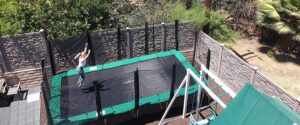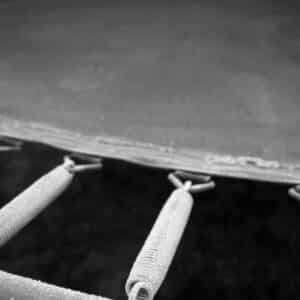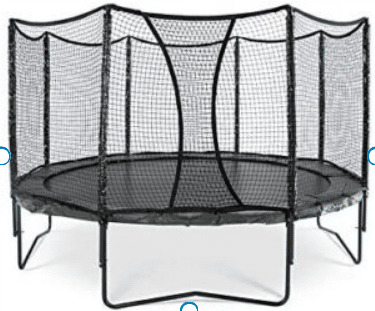
Discovering the best trampoline for gymnastics isn’t just about finding an outdoor trampoline; it’s about unlocking new training drills and skills. Trampolines are a fantastic way to keep children active and improve their gymnastics skills.
Rectangular shaped trampolines are ideal for gymnastics because they offer increased length to practice Tumbling type skills like Round off and Back Handspring, so we have focused heavily on this type of Trampoline.
Undoubtedly, the best Trampoline for gymnastics right now is the JumpKing. It’s used by thousands of gymnasts around the world including at elite level. The bounce is ideal for more advanced tumbling and their customer service is excellent.
However, a JumpKing isn’t cheap so if you’re looking for something mid range and ideal for both beginners and competitive gymnasts, Zero Gravity are for you.
Read on to discover the pros and cons of the best outdoor Trampolines around at the moment, especially for budding gymnasts.
Features

Winner
Jump King Deluxe

Runner Up
Zero Gravity

Best Value
Big Air
Price
£919
£380
£180
Dimensions
10′ x 14′
10′ x 15′
14′
Weight Capacity
120 Kilos
130 Kilos
120 Kilos
Amazon Rating
Factors to Consider When Choosing a Trampoline for Gymnastics
- Shape
Rectangular-shaped trampolines are ideal for gymnasts as they provide length and space to perform the greatest range of gymnastics skills. Round and square-shaped trampolines do not offer the same amount of length so whilst they are still useful for basic skills, a gymnast will become increasingly frustrated with the lack of space.
Rectangular-shaped trampolines also generate more bounce, which is why standard competition trampolines are in this shape as well.
- Safety Features
Safety should be the foremost consideration when choosing a trampoline for gymnastics. Look for features such as sturdy frames, safety nets, and padding that covers the springs and frame edges. A trampoline with an enclosure system provides additional protection, preventing accidental falls.
- Size and Weight Capacity
Consider the size of the trampoline and ensure it has sufficient space for gymnastic-type skills like cartwheels, round-offs, back handsprings and somersaults. Additionally, check the weight capacity to ensure it accommodates the intended users, and includes enough capacity for growth as your children get older.
There are two types of weight capacities: static and jumping. Pay most attention to the jumping capacity as the static capacity only refers to the maximum weight when people are not jumping. A high static weight capacity might look impressive but isn’t as useful as knowing the maximum jumping capacity.
- Durability and Materials
A trampoline for gymnastics needs to withstand rigorous use. Look for trampolines made from high-quality materials, such as galvanized steel frames and UV-resistant jumping mats. These materials contribute to the trampoline’s durability and longevity.
- Bounce Quality
The bounce quality of a trampoline is crucial for gymnastics training. It should provide a consistent and controlled bounce, allowing gymnasts to execute their movements accurately. Look for trampolines with heavy-duty springs that offer good tension and responsiveness.
- Portability and Storage Options
If you need to transport or store the trampoline frequently, consider its portability and storage options. Look for models that are easy to assemble, disassemble, and fold for convenient storage or transportation.
For many people, portability won’t be an influencing factor as the trampoline will stay in one permanent position.
- Price Range
Trampolines for gymnastics come in a wide range of prices. Set a budget and consider the features and quality that align with your needs. While it’s essential to find a reasonably priced trampoline, remember that investing in a durable and safe option is crucial for long-term use.
The Best Trampoline for Gymnastics
Let’s dive into the best overall trampoline for gymnastics. JumpKing claims to have the ultimate gymnastics trampoline with its fancy “over-under” spring setup. Happy customers back up the claim, so it seems legit.
Here’s what sets this awesome trampoline apart from the rest. First, it can handle a whopping 120 Kilos, making it a heavyweight champ. That means it can accommodate young gymnasts well into their teenage years.

Now, check out the safety net. It’s designed with bent poles that not only keep you safe but also create an illusion of more space. It’s like stepping into a trampoline TARDIS! Plus, the net is securely attached between the springs and the mat, so you can bounce freely without worries.
Let’s talk about the mat. It’s a vibrant green color, and there’s a good reason for that. It’s designed to keep the surface cool even on scorching hot days. The special weave allows proper airflow, so you won’t burn your feet and get blisters. Say goodbye to painful jumps in the summer!
This trampoline is built to last. The frame is made of galvanized steel, so it can handle the test of time. It weighs around 400 lbs, so once you find the perfect spot, moving it will be a tough job. But hey, it will stay strong and give you endless hours of bouncing fun.
Reviewers have lauded the ease with which this trampoline can be assembled, even when undertaken single-handedly.
So, if you want the best trampoline for gymnastics, JumpKing’s got you covered.
Runner Up
One of the standout features of the Zero Gravity Trampoline is its impressive weight capacity. This trampoline is built to accommodate up to 130 Kilos, making it suitable for multiple users at a time. This high weight capacity is a testament to the trampoline’s robust construction and high-quality materials.
Parents can feel confident that their children, and even they themselves, can jump and play without worrying about exceeding the trampoline’s limits.
The Zero Gravity Trampoline boasts curved sides which look like a barrel. This unusual shape provides additional strength in the frame, offering a larger area compared to standard rectangular trampolines.
This design is ideal for practicing flips, jumps, and other gymnastics routines. The yellow and blue color scheme is both stylish and visually appealing, ensuring the trampoline complements any backyard setup.
If you have younger gymnasts around the ages of 5 to 7 years old, they may not feel the benefit of the huge size so you may want to opt for a slightly smaller and less expensive option like the Big Air trampoline below.
Best Value Trampoline for Gymnastics
If you are looking for great quality but don’t want to spend a huge amount plus then Big Air is for you. Big Air is a well-established brand that you can trust and their trampolines are durable.
You’ll get all the safety features you would expect on a high-end product such as the safety enclosure and thick padding.
The only drawback is the slightly smaller area of 14 feet compared with some trampolines that stretch as far as 18 or 20 feet in length. This won’t be an issue for younger children but those around 11 or 12 years or older will begin to feel limited by the space. The extra three or four feet are more noticeable when trying to link two skills together like a round-off and back handspring.
There is only one colour option – blue. It looks good but is not as stylish as other more expensive brands such as JumpKing. But if you’re looking for value for money, something has to give.
Best Premium Trampoline for Gymnastics
Galactic Xtreme is in the business of making trampolines aimed at gymnasts and although they are not cheap, they are well worth the investment. Their rectangular trampoline range extends up to a huge 13′ by 23′ which is possibly the longest on the market though they do offer smaller versions as well as round and square-shaped versions too.
The rectangular option features 3mm thick galvanized steel frames which are comparable to FIG standard competition trampolines. Many reviewers point out that this gives an added feeling of safety and durability.

The strong frame means that up to 750 Ibs of weight can be supported at once. So although we don’t recommend having multiple people on at once for safety reasons, it does illustrate the quality of the design and manufacturing.
There has been feedback questioning the design of the safety netting as some gaps can appear near the top of the net if not assembled correctly.
However, if you are looking for something on the large side that’s top of the range, then Happy Trampoline is for you. Just make sure you have enough room to fit it all in!
Best Alternative Trampoline for Gymnastics
Admittedly we have only been recommending rectangular trampolines for gymnastics so far but for the last pick and best alternative here is a round trampoline 12 feet in diameter.
Maybe you don’t have the room for a large rectangular trampoline or you just prefer the look of a round trampoline. Either way, Alley Oop is one of the best-known brands for outdoor trampolines so it made sense to share our view on their product.
Alley Oop is known for providing a great quality bounce and overall quality of their trampolines. The stitching on the padding is very good and will last a long time.
In fact, there is a lifetime warranty on their trampolines which illustrates a great level of confidence in what they sell.
One drawback is the fact some accessories such as the step ladder have to be purchased separately. However, as a mid-price range product, the cost overall including accessories such as this still won’t break the bank.
Tips for Using a Trampoline for Gymnastics
Using a trampoline for gymnastics requires proper techniques and precautions to ensure safety and maximize performance. Here are some essential tips:
- Always supervise children and beginners when using a trampoline.
- Clear the surrounding area of any hazards or obstacles.
- Remove shoes.
- Check the safety netting and trampoline frame for signs of damage or wear and tear.
Before starting any gymnastics on a trampoline, it’s crucial to warm up and stretch your muscles properly. This helps prevent injuries and improves flexibility.
Learn and practice basic gymnastics shapes suited for trampoline use, such as tuck, pike, and straddle. Follow proper progressions and consult with a qualified coach for guidance.
Extending the Lifespan of your Trampoline
To understand how to make your outdoor trampoline last longer, it’s essential to consider the factors that can impact its lifespan.

Material Quality
- Opt for trampolines made from high-quality materials that are resistant to weathering and wear.
- Look for rust-resistant frames and durable jumping mats that can withstand frequent use.
Proper Installation and Placement
- Follow the manufacturer’s instructions for installation to ensure the trampoline is set up correctly.
- Choose a suitable location that provides enough space and has a level surface to prevent unnecessary strain on the trampoline’s structure.
If you have the budget and space I would always recommend building a hole in the ground so you have an in-ground trampoline. As well as protecting the trampoline from the elements, it is much safer to use.
Regular Inspections and Maintenance
Regularly clean the jumping mat and frame with mild detergent and water. Remove debris or leaves from the springs or frame. When not in use, store the trampoline in a dry and covered area to protect it from weather elements.
Periodically inspect the trampoline for any signs of wear, loose parts, or damage. Tighten screws or bolts as needed. Replace worn-out or damaged parts promptly to maintain safety. Typically the parts which wear fastest are the pads and safety enclosures.
Springs can loose their tension over time and should be replaced when they look like they are permanently over stretched. The actual mat (bed) of the Trampoline can become frayed or worn so watch out for that. Even a small tear will quickly become larger and very dangerous.
Replacement Parts and Repairs
If any component of your trampoline becomes damaged or worn out, ensure you can easily access replacement parts or professional repair services. This helps extend the lifespan of the trampoline and ensures its continued functionality.
How to Winterize a Trampoline
Winterizing a trampoline is an essential process for anyone looking to extend the lifespan of their outdoor trampoline. It involves a series of steps to protect the trampoline from the damaging effects of cold, snow, and strong winds. Given that certain parts of the trampoline, like the frame pads and jumping mat, are more prone to damage during winter, proper winterization is crucial.

Trampolines are made to be used in warm weather, and they are not designed to withstand the cold and snow. Winterizing your trampoline will help protect it from the elements, preventing damage and prolonging its lifespan.
Winterizing your trampoline has several benefits, including:
- Protection from harsh weather conditions
- Prevention of rust and corrosion
- Longevity of trampoline parts
- Safe storage until next use
Before you start winterizing your trampoline, it is important to take some safety precautions to avoid accidents.
Make sure that the trampoline is clean and dry before you start disassembling it. Check for any damage or wear and tear, and repair or replace any damaged parts.
Wear protective gloves and goggles to protect your hands and eyes while handling the trampoline components.
- Do not attempt to winterize your trampoline in windy or wet weather conditions.
- Make sure that there is no one on the trampoline while you are disassembling it.
- Use a ladder or step stool to reach the higher parts of the trampoline.
Steps to Winterize Your Trampoline
- Clean the trampoline. Begin your trampoline winterization process by thoroughly cleaning it. Remove all dirt and debris, and focus on eliminating stubborn stains on the springs or foam padding. Rust spots on metal parts, a common issue during damp conditions, should be scrubbed and rinsed off.
- Remove the trampoline mat by detaching it from the springs using a spring puller. Fold it carefully and store it in a dry place. If you don’t have a spring puller you will need to wear thick gloves to protect your skin from getting caught in the springs. The springs open and close really quickly and its easy to get pinched as they close.
- Detach the springs from the frame of the trampoline. Now the mat has already been detached the springs will be hanging loosely from the frame and can be easily detached. Store the springs in a container or bag, making sure that they are clean and dry.
- Store the trampoline mat and springs in a dry and cool place, such as a shed or garage. Make sure to keep them away from moisture and direct sunlight to prevent damage.
- You can either leave the frame and legs set up outside or dismantle them and store them. If you choose to leave them set up, cover the trampoline frame and legs with a weather-resistant cover to protect them from the harsh winter weather. This will also prevent dust and debris from accumulating on the trampoline.
- A weather cover is your best friend when figuring out how to winterize a trampoline! It shields against moisture and falling debris, like tree branches. Especially in areas prone to high winds, securing the trampoline with bungee cords and a weather cover is vital.
- If you can store the trampoline, do so in a dry and cool place. Make sure that it is properly secured to prevent it from falling or tipping over.

Conclusion
Choosing the best trampoline for gymnastics must involve selecting a rectangular shape as it provides the most room to practice gymnastics-type skills. Whilst trampolines don’t have to be expensive, I recommend investing in a high-quality trampoline from a well-known brand as they will last for longer and provide a bigger bounce than some of the cheaper alternatives.
FAQs
Here are some frequently asked questions about trampolines for gymnastics:
Can I use any trampoline for gymnastics?
While any shape trampoline can be used for basic gymnastics skills, it’s recommended to choose a rectangular shape trampoline for gymnastics. These trampolines usually offer better bounce quality and have more length to perform tumbling-type gymnastics skills.
What size trampoline is suitable for gymnastics?
The size of the trampoline depends on the available space and the gymnast’s skill level. For beginners or younger gymnasts, a smaller-sized trampoline, such as 8 to 10 feet in length, may be sufficient. Advanced gymnasts may require larger trampolines, ranging from 12 to 18 feet in length. The largest trampoline we’ve seen on the Amazon is around 13′ x 23′.
Are there weight restrictions for trampolines used in gymnastics?
Trampolines have weight capacity limits specified by the manufacturer. It’s essential to choose a trampoline that can safely accommodate the weight of the gymnast or multiple users if applicable. Always check the weight capacity and adhere to the recommended limits.
How do I ensure the safety of my trampoline for gymnastics?
Ensure your trampoline has safety features such as a sturdy frame, safety net enclosure, and padded edges. Follow safety guidelines, supervise users, and use appropriate safety equipment. Regularly inspect the trampoline for any signs of wear or damage. In-ground trampolines are safer than above-ground but will be more expensive as you will have to build a hole big enough to sink the trampoline into.
Can adults use trampolines designed for gymnastics?
Yes, trampolines designed for gymnastics can be used by adults as well. However, ensure the trampoline has a suitable weight capacity and meets the safety requirements for adult users.
- How To Get Over a Mental Block In Gymnastics: A Complete Guide
 Gymnastics is a sport that requires not only physical strength and skill but also mental strength. When a gymnast feels like they cannot attempt a… Read more: How To Get Over a Mental Block In Gymnastics: A Complete Guide
Gymnastics is a sport that requires not only physical strength and skill but also mental strength. When a gymnast feels like they cannot attempt a… Read more: How To Get Over a Mental Block In Gymnastics: A Complete Guide - Find The Best Leotard For Girls (Guide)
 Finding an ideal leotard for girls isn’t just about picking a dazzling design that sparkles (although it does help!). The leotard has to fit perfectly,… Read more: Find The Best Leotard For Girls (Guide)
Finding an ideal leotard for girls isn’t just about picking a dazzling design that sparkles (although it does help!). The leotard has to fit perfectly,… Read more: Find The Best Leotard For Girls (Guide) - The Best Gymnastics Shorts (Our Top Picks)
 The best gymnastics shorts are designed to be worn over the top of a leotard providing additional coverage around the upper legs, whilst allowing gymnasts… Read more: The Best Gymnastics Shorts (Our Top Picks)
The best gymnastics shorts are designed to be worn over the top of a leotard providing additional coverage around the upper legs, whilst allowing gymnasts… Read more: The Best Gymnastics Shorts (Our Top Picks) - Decathlon Leotards – Are They Any Good?
 If you’re in the market for a new leotard, you may be wondering if Decathlon leotards are any good considering the low cost of their… Read more: Decathlon Leotards – Are They Any Good?
If you’re in the market for a new leotard, you may be wondering if Decathlon leotards are any good considering the low cost of their… Read more: Decathlon Leotards – Are They Any Good? - A Complete Guide to Gymnastics Hand Rips
 Are you tired of dealing with painful gymnastics rips on your hands from training? Look no further – this article offers a comprehensive approach to… Read more: A Complete Guide to Gymnastics Hand Rips
Are you tired of dealing with painful gymnastics rips on your hands from training? Look no further – this article offers a comprehensive approach to… Read more: A Complete Guide to Gymnastics Hand Rips - Is Gymnastics Dangerous? (Facts and Comparisons)
 Gymnastics is acknowledged as a highly technical and physically demanding sport. It inherently carries a risk of injury, which is why most coaches and clubs… Read more: Is Gymnastics Dangerous? (Facts and Comparisons)
Gymnastics is acknowledged as a highly technical and physically demanding sport. It inherently carries a risk of injury, which is why most coaches and clubs… Read more: Is Gymnastics Dangerous? (Facts and Comparisons)


